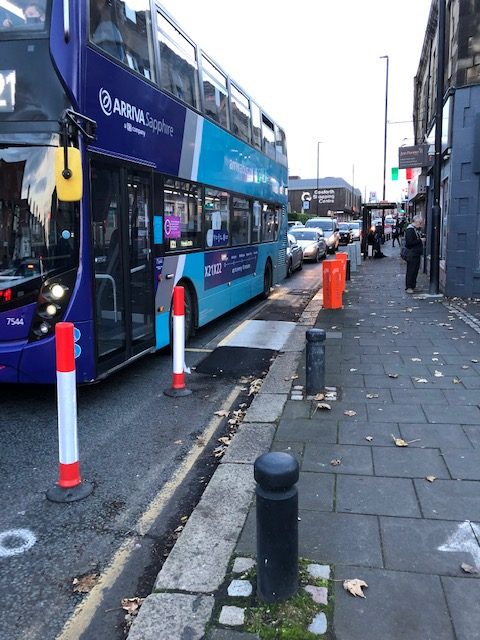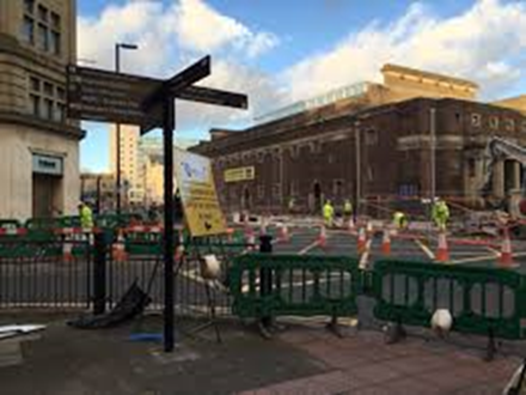Blog
Read All About It!
Please get the message. Prioritise fast chargers for EV for 21st Century travel. Cycle lanes are for yesterday.

You now have all-revealing photos and Next Door.co.uk’s 79% Gosforth poll.
Cycle lanes are not the future. I have been trying to flag this up since 9 October 2014 when I first wrote to the Newcastle City Council with my complaint about proposed cycle lanes and red lines for Gosforth High Street, hitting the fan ever since.
There is now no need for more words, legal or otherwise.
Photographs show with total clarity that cycle lanes on Gosforth High Street that I have consistently objected to,( then marked by white and red lines, today marked by bollards,) make the pollution they were introduced to reduce, more not less; slow-moving traffic tailing back both ways even during lockdown an almost permanent feature of the High Street.
They do not encourage more people to make a “model shift” from car to bike that those responsible dream of.
There were few bicycles in the first place, and just as few today. Nationally in UK figures flatline. The vision of the authors of the plan, the cycling lobby Sustrans entrusted with the job of introducing it in Newcastle and endorsed by the Council, “1,232,177 additional cycling rides” is truly bizarre when measured against National Cycling to Work Stats in Newcastle up from 1,781 in 2001 to 3,223 in 2011.
Serious injuries to cyclists suppressio veri, suggestio falsi. RoSPA’s stats for DfT are drawn from the police, not from the NHS, with true figures best kept unknown.
Consultation, again in my own experience, a con plus salutation. Opacity, not transparency. Justice is seen to be done when it is not.
Recently, to try to make them acceptable, some cycle lanes on the High Street have been designated pedestrian ways to achieve social distancing in Covid-19, but few pedestrians walk in the gutter and, for the few cyclists around, they make cycling even more dangerous and unhealthy when they have to squeeze in between the pedestrian ways and the slow-moving buses, lorries, and cars.
Gosforth High Street is just one illustration of many throughout the UK. Only the Daily Mail defies Omertà.
Cyclists have a free license to ride their bikes on most roads, but they have a minority right to be there, not an equal one, and others, especially the emergency services, have a greater one. And we now have the unregulated e. Scooters at 15 mph with a license to injure.
Electric Vehicles are the future
In China, where once upon a time their roads were full of cyclists, there are already well over a million people with small affordable electric cars. Cycles, rest in peace!
130 million people in America are within a 10-mile drive of an EVGO fast charger. No Luddites there. No Sustrans!
Deserving better here, all those from whom there are little, nameless, unremembered acts of kindness and of love. Many of them.
I hope that one day students of law, politics and sociology will be able to read Kafka’s Cycle – slow death of a complaint where I chronicle all this, and lawyers will stop threatening to sue me for libel refusing even to read it.
PLEASE SHARE WITH YOUR FRIENDS AND COLLEAGUES
“Crap” Cycle lanes increase the toxic fumes on Gosforth High Street, Newcastle and scarcely any cyclists! UGH

THIS IS AN UNHOLY MESS! Not the only one.
Gosforth High Street is a section of the main arterial road that starts at the main bridge over the Tyne, bypasses the city centre, going North with Jesmond to the East of it and the Town Moor to the West.
Before it heads North, when it passes through the shopping centre for Gosforth, it is known as Gosforth High Street. It is so narrow at this point that when a local trader measured it for me, he said that the width of four bus stops was wider than the width of the road.
Congestion here is chronic, partly because it is narrow, partly because it is the main arterial road for buses, emergency vehicles and vans, lorries, and cars, and partly because it supports the shopping centre for all the amenities that are there with vans and security vehicles regularly loading and unloading there. There are banks, building societies, estate agents, cafes and restaurants, a busy hardware shop, travel agents, charity shops &c.
Prominent on Gosforth High Street is Trinity Church that has had over £1m spent on it making it a hub for 78 different organisations in the city. Its own car park holds only about a dozen cars. Many organisations have evening meetings in Trinity Church, including the one I used to chair – the Tyneside Decorative & Fine Arts Society, now known as the Arts Society.
There are over 5 “green men” pedestrian crossings creating three real and unavoidable bottle-necks > one a traffic light-controlled crossing at St. Nicholas’s Avenue where the cars enter and exit the large 160 car park above Gosforth’s Shopping Precinct that includes Sainsbury, Boots and W H Smith > one a bus stop on both sides of the road for diesel buses serving twelve bus routes running North of the city, > and one at the Northern end of the High Street controlling access to a major crossroad adjoining the Salters Road car park. (The picture above) ”
In 2014 the Council had this plan designed by the cycling charity, Sustrans:


They consulted the public with drawings of the future and a choice of sorts. Their choice.
What they lacked in accuracy, Sustrans compensated for with their megawatt imagination and their design flair. Measure National Cycling to Work Stats for Newcastle 1,781 in 2001 up to 3,223 in 2011 against their forecast of 1,232,177 additional cycling rides. The cycling lobby’s role in all this and their vision a closely guarded secret.
At the time the project manager sent me an email saying “The current cycling figures are lower than we would like, and these changes will help increase the numbers of cyclists using the junction and the high street. Currently, there are less than 1000 cyclists a day using the High street, but we want to see that grow so that 20% of all trips in Newcastle use this mode. Given that 30,000 vehicles use the Great North Road per day for return trips then it is not unreasonable to see that figure grow to 3 or 4 thousand return trips by bicycle.” <my underlining>A local estate agent commissioned a check on the number of cyclists using the High Street. The figure he came up with – 70, some probably on return journeys.
I have nothing against cyclists – I used to cycle to school, and I cycled at University – but I do not share the belief of Sustrans and others that once you provide cycle lanes, some positive encouragement to cycling and some real discouragement to motoring, outside London, Oxford and Cambridge significant numbers of motorists will abandon their cars for a bicycle. The weather, narrow, congested roads including potholes, and above all the risk of serious injury work against it.
The main hope to get clean air must now be to accelerate the purchase of electric vehicles.
I shall now try to make what was a long personal experience as short as I can.
It is now easy to get a clear picture of the real world the Council and Sustrans had in mind in the first half of the decade. In 2020 Covid-19 struck with a worldwide pandemic. The Government thought it would help if more people could cycle instead of using public transport. They paid local authorities to facilitate that. Newcastle was happy to oblige with the plan they had had some second thoughts about. No red lines, just bollards designating the cycle lanes on Gosforth High Street. Some recent photographs illustrate it. Imagine “3 or 4 thousand return trips a day” by cyclists using them.


Initially, the cycle lanes were intermittent on the western side of the High Street with cyclists having to cycle in the traffic or on the pavement on the eastern side. I saw both. This may be the shortest cycle lane in the UK on the eastern side.

Then they squeezed some more cycle lanes on the eastern side, again intermittent. Most recently they then designated some, as above, pedestrian walkways, leaving others, largely unused, as cycle lanes.
You can see a number of things. The narrowness of the cycle lane. The bus parked in the traffic lane with pedestrians having to cross the cycle lane. (I underlined in my description of the High Street.) The cause of the long tailback, with slow-moving traffic now generating even more poisonous toxic emissions than they normally would; as scientists keep saying, shortening everyone’s lives.
You now have the worst of all worlds. Slower traffic, more pollution, some very narrow largely unused cycle lanes and now a few pedestrian walkways as well. The few cyclists there are do not usually use the cycle lanes.
Here opposite sides of the same part of the High Street. The top photograph shows a cycle lane recently converted into a short pedestrian walkway. The bottom photograph shows a cycle lane converted into a pedestrian walkway, and if you look closely you will see a cyclist directed with road markings into the traffic lane with its tailback, inhaling poisonous emissions.

Travelling South.

Look at the cyclists who will be inhaling toxic fumes
Travelling North
You now have the worst of all possible worlds for absolutely everyone. And scientists say fumes shorten lives. Compare and contrast these pictures with the drawings provided in the 2014 consultation, artistic licence there was truly imaginative.
And nobody knows – nobody asks A & E – the true figures of serious accidents to cyclists. “Although the number of deaths is accurate, there could be two or three times as many seriously injured cyclists and double the number of slightly injured.“ RoSPA and the DfT get accident stats from incidents reported to the police.
And an accident waiting to happen here if a third cyclist comes along.

The local Labour candidate writes “we can build on one of the very few positive impacts of Covid-19, namely improved air quality …for a greener Gosforth”. UGH
After he died, at the Wake, “Would someone be saying a good word for Patrick?” Long silence. “His brother, Michael, was worse.“
The £18m spend in a period of austerity on John Dobson Street, Newcastle, known locally as a “skateboard park“, was worse than the above.


The South of England is another story.
PLEASE SHARE WITH FRIENDS & COLLEAGUES
Do’s and Don’ts for Human Rights Lawyers … and Play Fair 🙏

Geoffrey Bindman now writes “Erskine and Birkett were heroes of our profession but they were obviously not aware of your situation which arose many years after their deaths. You dishonour their memory by claiming their support for a baseless complaint.” I shall tweak this to respond with a more detailed response later.
Lots of people have different rights on the roads, in education, in the Middle East, everywhere. Often they conflict.
What happens next?
I quote Sir Norman Birkett, 1st Baron Birkett Kt, PC, QC on lawyers’ professional responsibility.
The lawyer “puts forward to the court submissions which he may or may not think sound, but that is the role of the advocate. …. He may be putting forward a view of which he profoundly disapproves, but he is putting forward for the client, the view of the client.”
That is what I paid Bindmans LLP to do, namely to write a pre-action protocol letter that the assistant local government Ombudsman said that I should secure from a solicitor if I wished to initiate a judicial review against her decision that had rejected my complaint about the proposed cycle lanes and red lines on Gosforth High Street in Newcastle.
Visit my earlier post and see four photographs and an extract from Newcastle Council’s Ambitions Bid – today bollards designate the cycle lanes the Council had in mind at the time. Lawyers from Bindmans LLP dismissed a 100-page dossier I had given them and said that judicial review would be “bound to fail”, professionally neither they nor I, as a non-practising barrister, could write the letter.
I would like to put this in the public domain, but Bindmans LLP will not read what I write. They threaten to sue me for libel if I publish it, and the Solicitors Regulation Authority describes this as “robust”.
This is how I think people should assert their rights, the system should facilitate it, not make it difficult or impossible to do so. Lawyers should assist them.
GREEN – GO for them.
BUT
RED – STOP! Do not ignore your neighbours’ rights when they are different and right for them. Do not abuse your rights.
Human rights do not licence selfishness and suppressio veri. And, what is right for you may well not be right for everyone. Recognise that.
Remember people are equal only sometimes, unequal most times, and always different.
Pursue excellence. And play fair.
PLEASE SHARE
PLEASE SHARE
